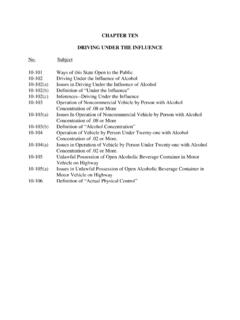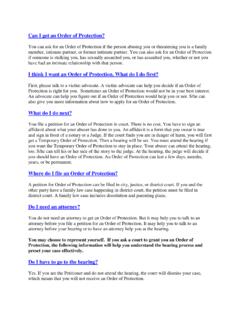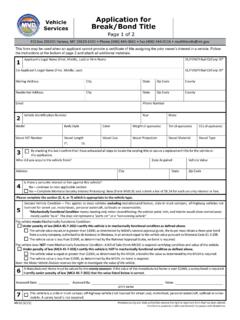Transcription of SUBSTANCE USE IN MONTANA
1 2017 SUBSTANCE Use in MONTANA | 1 September 2017 A summary of state level initiatives for the Department of JusticeSUBSTANCE USE IN MONTANAE nforcement | Monitoring | Treatment | Prevention | Drug Endangered 2 | SUBSTANCE use in MONTANA 2017 Dear Fellow MontanansOn April 19, 2017, my office launched Aid MONTANA : Addressing the Impact of Drugs, a comprehensive initiative to combat MONTANA s growing SUBSTANCE abuse epidemic. The multitude of efforts in our state to curb SUBSTANCE abuse clearly aren t enough to adequately address the problem. We need something different. To get the discussion going on how we can develop a statewide strategic plan on addiction, I commissioned this report, which is a high-level overview of all the many ways the State of MONTANA is working to address SUBSTANCE use within its borders. While many dollars have been directed over the years toward trying to stem the tide, the systems they fund are not always well coordinated.
2 We are seeing an alarming increase in the number of drug offenses in the justice system, which contributes to overcrowding in our jails, courts, and prisons. We are also seeing big changes in the way we provide treatment and the evidence-based methods for treating SUBSTANCE Use Disorder (SUD) that MONTANA has not fully adopted yet. We need to coordinate our efforts and ensure our public dollars are invested wisely to give individuals with SUD the best possible chance at long-term recovery. As this report reflects, our situation is grim: The total number of drug offenses in MONTANA has increased 559% since 1980. Drug violations driven by methamphetamine use, which went down from 2005 to 2010, spiked again in 2015. That same year, 57% of all violations were for marijuana, followed by methamphetamine at 31% and other narcotics at 7%. Heroin contributes to a smaller overall share of violations, but increased an astronomical 1,557% from 2010 to 2015.
3 Of the adult felony convictions in MONTANA , 40% of all convictions are for possession or distribution of drugs or felony DUI, which make up three of our top five felony conviction data is clear: Our state is in the midst of an epidemic. And with the Aid MONTANA initiative, we hope to tackle this epidemic head-on. It is our goal to have the blueprint for a strategic plan completed before the 2019 legislative session, so we can present a roadmap to lawmakers to efficiently combat this problem. Whether it means shifting resources to find where they are most effective, or changing laws to better reflect the reality of the problem, we want po-licymakers to have a clear understanding of what needs to be done. We heard over and over from attendees of the MONTANA Healthcare Foundation s listening sessions this summer that a combination of ideas from those in the prevention, law enforcement, and treatment fields, as well as from SUD survivors, may yield the most innovative and effective results.
4 Fighting the effects of addictive substances should be immune from partisan politics, as I believe we each have a moral obligation to do our part. I encourage all Montanans to join me in this fight, because together, we can solve this problem. Our communities can t wait another minute longer. Tim Fox | MONTANA Attorney General2017 SUBSTANCE Use in MONTANA | 3 ContentsIntroduction 4 Background 5 Enforcement 8 Monitoring 35 Treatment 44 Prevention 63 Drug endangered children 75 Conclusion 83 References 844 | SUBSTANCE Use in MONTANA 2017 IntroductionSubstance use impacts the health and well-being of individuals across the lifespan in MONTANA , exacting a high societal cost on our state s public and private systems.
5 From drug endangered children in foster care to suicide rates, jail over-crowding to motor vehicle fatalities, the full impact of SUBSTANCE use is as hard to underestimate as it is to quantify. To better elucidate the role of the MONTANA state government in combating SUBSTANCE use, the MONTANA Department of Justice commissioned a study in the summer of 2016 attempting to summarize the publicly available data and informa-tion related to state-level programs that address SUBSTANCE use enforcement, treatment, monitoring and prevention in MONTANA . The research also incorporated programs related to drug endangered children. The methodology for this project included key stakeholder interviews with more than 40 state and local officials as well as a review of relevant re-search and key programmatic data from public programs and initiatives. This project is a small piece of the Aid MONTANA initiative sponsored by Attorney General Tim Fox which seeks to address the devastating impacts of SUBSTANCE use in our following report summarizes the major initiatives led by the State of MONTANA to address the problem of SUBSTANCE use.
6 Some successful local programs and statewide initiatives not operated by the State are also highlighted. The report is organized into five chapters: Chapter 1 - Enforcement Chapter 2 - Monitoring Chapter 3 - Treatment Chapter 4 Prevention Chapter 5 - Drug Endangered ChildrenFor more questions about the information contained in this report, contact Katie Loveland MPH, MSW at 406-431-9260 or in 10 Montanans is dependent on or abusing alcohol or drugs. Sixty-one percent of MONTANA high school students who drink engage in binge drinking behavior. 2017 SUBSTANCE Use in MONTANA | 5 Alcohol UseSubstance use is a pressing concern in the state of Mon-tana, affecting thousands of individuals and families each year. Alcohol is the most commonly used SUBSTANCE in our state. One in five MONTANA adults reports binge drinking in the last month ( ) compared to of adults in the US, and of adults in MONTANA are classified as heavy drinkers, significantly higher than the US rate of High rates of alcohol consumption start early in MONTANA .
7 Seven out of ten high school students report ever having used alcohol, significantly higher than the rate among high school students in the US. Thirty-four percent of high school students in our state report alcohol use in the past month and 20% report binge drinking during the same time period. This means that, of the high school students who are currently using alcohol, 61% are enga-ging in binge drinking Centers for Disease Control estimates that there were 390 alcohol attributable deaths in MONTANA from 2006 to 2010, for an overall alcohol attributable death rate of per 100,000, the highest rate in the country. Every year, more than 11,000 years of potential life are lost in Monta-na due to Though high rates of alcohol use are the primary factor in MONTANA s elevated rates of reported SUBSTANCE use compared to the US, illicit drug use is also a con-cern in our state. One in five high school students reports current marijuana use ( ), 8% report ever using inhalants and 16% report abuse of prescription drugs in their lifetime.
8 The con-cerning trends in illicit drug use continue into adulthood. According to the 2012-2013 National Survey on Drug Use and Health, almost one in four young adults in MONTANA reports illicit drug use in the past month, including 23% of young adults who report currently using marijuana and 9% who report non-medical use of pain relievers in the last Illicit Drug UseAge 12-17 Age 18-25 Age 26+MT Rank out of 50 StatesIllicit drug use in the past use in the past alcohol use in the past use of pain relievers in the past 1. Alcohol and illicit drug use in MONTANA by age group, 2012-2013, National Survey on Drug Use and Health drinkingBinge drinkingHeavy drinkingPercentAlcohol consumption in MONTANA and the US, 2015 MontanaUS6 | SUBSTANCE Use in MONTANA 2017 One in four young adults in MONTANA used illicit drugs in the last monthDependence and AbuseHigh rates of alcohol and drug use also lead to high rates of dependence on and abuse of these substances.
9 The National Survey of Drug Use and Health estimates that 18,000 Montanans aged 18+ are dependent on or abusing illicit drugs and 66,500 Montanans are dependent on or abusing alcohol. In all, one in 10 Montanans is depen-dent on or abusing alcohol or Health Consequences ofSubstance Use DisordersEvery year, SUBSTANCE use contributes to more than 20,000 hospital and emergency room (ER) visits in Mon-tana. From 2010 to 2014, the total charges for the nearly 110,000 ER and hospital visits with a primary or secondary diagnosis of SUBSTANCE use totaled $796 million, more than $150 million More than 100 people die every year due to drug overdo-se in MONTANA , with 1,334 deaths recorded in MONTANA between 2003 and Opioids are the most common SUBSTANCE associated with drug poisoning deaths, accoun-ting for 42% of all deaths in this category in 2013-2014. Nationally, each death from opioids is estimated to cost more than $33,000, and MONTANA estimates that the cost of prescription opioid deaths annually in our state is $ Drug and alcohol use are also key contributors to Mon-tana s high rates of suicide.
10 The adult suicide rate in our state is consistently twice the rate in the United States. In 2013, MONTANA had the highest rate of suicide of any state in the US at per 100,000 compared to per 100,000 for the MONTANA also has the second hig-hest rate of alcohol related deaths in the US. The link be-tween mental health, SUBSTANCE use and suicide is clear. In a recent study by the Suicide Mortality Review team, of the suicide victims in MONTANA who had SUBSTANCE use involvement assessed, forty-eight percent had alcohol in their system at the time of death, 21% had narcotic pain killers and 17% had marijuana. Underdiagnosis of mental health issues and high rates of alcohol and drug abuse contribute to the suicide epidemic in our state; only 40% of suicides in this study had an identified mental health diagnosis at the time of MONTANA s suicide rate is twice that of the US. Suicides often involve SUBSTANCE use.









